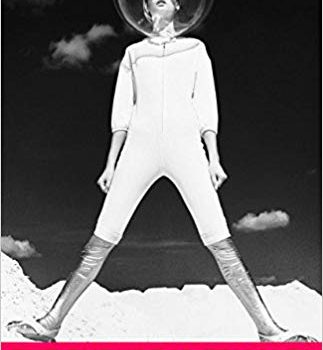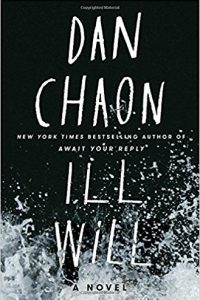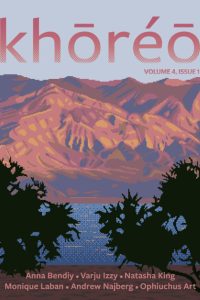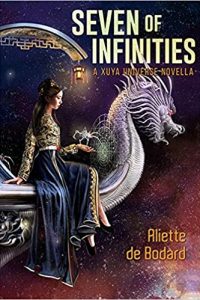Gary K. Wolfe Reviews The Future is Female!, edited by Lisa Yaszek
 The Future is Female! 25 Classic Science Fiction Stories by Women, from Pulp Pioneers to Ursula K. Le Guin, Lisa Yaszek, ed. (Library of America 978-1-59853-580-8, $27.95, 532pp, hc) September 2018.
The Future is Female! 25 Classic Science Fiction Stories by Women, from Pulp Pioneers to Ursula K. Le Guin, Lisa Yaszek, ed. (Library of America 978-1-59853-580-8, $27.95, 532pp, hc) September 2018.
In her pioneering 2016 anthology Sisters of Tomorrow, Lisa Yaszek brought to light a number of women SF writers of the pulp era, most long forgotten and out of print for decades. Now, with The Future is Female! 25 Classic Science Fiction Stories by Women, from Pulp Pioneers to Ursula K. Le Guin, she extends her survey of SF by women through the 1960s, ending with Le Guin’s familiar cloning classic “Nine Live” and the less familiar James Tiptree, Jr. story “The Last Flight of Dr. Ain”, both from 1969. (She doesn’t include any pre-pulp era writers and limits herself mostly to SF periodicals, so don’t go looking for Charlotte Perkins Gilman or Francis Stevens.) Since the volume is a “Special Publication” from the Library of America – meaning it isn’t an official part of the Library’s quasi-canonical series – Yaszek is confined to American authors, but once again she finds interesting tales not only by names widely familiar today – Russ, Tiptree, Le Guin, Leigh Brackett, C.L. Moore, Kate Wilhelm, Kit Reed – but by some of those same pulp writers in her earlier anthology (although only Leslie Perri is represented with the same tale in both books, “Space Episode”). The selection is well-balanced, with three stories from before 1940, three from the 1940s, ten from the 1950s, and nine from the 1960s. In terms of rediscovering overlooked writers, the most interesting selections range from the late 1940s to the early 1960s; Yaszek even managed to uncover two writers I’d never heard of, Esquire editor Alice Glaser, whose only SF story appeared in F&SF in 1961, and Alice Eleanor Jones, who published only five stories, all in 1955, before moving on to a career in mainstream magazines. As these details suggest, Yaszek’s meticulously researched notes, sometimes even digging up census records to track down elusive figures, are a good part of what makes the book fascinating as literary history.
Whether or not we can draw useful conclusions from Yaszek’s selections, or whether we even ought to try, is another matter. Is the notion of “American women’s SF” much different from American SF or women’s SF, or SF in general, or is the whole thing something of a chimera? Yaszek’s approach is not to try to outline a particular tradition, such as feminist SF (though of course it’s well-represented in the final few selections), but rather to show how particular women writers contributed unique perspectives to stories that often followed the trends of the time. The 1920s saw a flurry of giant-insect stories, for example, and Clare Winger Harris’s “The Miracle of the Lily”, from 1928, features Venusian giant insects in a contrived twist conclusion that is another common narrative trick of the early Amazing Stories. Both this and Leslie F. Stone’s “The Conquest of Gola” are written in the middle-overripe style of the early pulps – neither as elegant as Clark Ashton Smith nor as blustery as Robert E. Howard – but Stone’s story introduces something very different: an all-female society on the planet Gola, which is invaded by the “ignoble male creatures” of the planet Detaxal. The Golans, it turns out, are not humanoid in form – they’re appalled not only by the masculinist values of the humans (who “breed for physical prowess, leaving the development of their sciences, their philosophies, and the contemplation of the abstract to a chosen few”), but by their very body designs. It’s almost certainly the closest thing from the pulp era to anticipate stories like Russ’s “When It Changed”.
But not surprisingly, the strongest pulp-era story here is C.L. Moore’s “The Black God’s Kiss”, the first of her Jirel of Joiry sword-and-sorcery tales, in which Jirel undertakes a terrifying underground journey to find an appropriate revenge against a barbarian goon who assaulted her. It shows convincingly how Moore managed to create an unapologetically kick-ass female hero in a subgenre dominated by proto-Schwarzeneggers, even though it’s more a horror tale than SF (it first appeared in Weird Tales); here the contemporary tale it most reminded me of is Kij Johnson’s Dream-Quest of Vellitt Boe, with its similar underground journey. The plot of the remaining pulp-era tale, Leslie Perri’s “Space Episode”, is almost as generic as its title (if there was ever a placeholding title that somehow made it into print, this is it), distinguished mainly by gender-shifting the self-sacrificing space explorer who saves the damaged ship, while the male crew members are paralyzed into “semi-coma”.
By the time we get to the postwar era, it’s clear that women writers are as preoccupied as anyone else with ideas of nuclear war and atomic mutations. Judith Merril’s classic “That Only a Mother” is here, though it’s a story that I’ve always felt trades in stereotypes of female hysterical denial (the mother insists her super-intelligent but limbless baby is normal). The mutant genius kids of Wilmar Shiras’s “In Hiding” (which formed the core of her 1953 novel Children of the Atom) are more convincing, though I have my doubts that the story was really a precursor of the X-Men, as Yaszek and others have suggested – you could make the same case for Van Vogt’s Slan and any number of other tales. The only real post-nuclear dystopia is Alice Eleanor Jones’s “Created He Them”, which is distinguished not only by its oppressive underpopulated society, but by its unusually acerbic portrait of an abusive husband. Both Katherine MacLean’s “Contagion” and Margaret St. Clair’s “The Inhabited Men” are the real oddball tales from this era, MacLean’s concerning a planetary colony in which the only effective treatment against a terrifying disease has the side effect of turning all the men into a cartoon parody of hypermasculinity – basically, they all look exactly like the old Brawny paper towel guy – while St. Clair’s is a collection of three fables about the fates of men inhabited by an alien intelligence. Perhaps the clearest example of the comical working-class argot that 1950s magazine writers seemed to think would last forever is Andre Norton’s “All Cats are Grey” (published as by “Andrew North”), a charming but minor tale of a brilliant computer operator, Steena of the Spaceways, who uses her deductive skill to track down a legendary space treasure. The other familiar classic from this period is Zenna Henderson’s “Ararat”, the first of her “People” stories and the one that lays out most effectively the isolated rural setting in which aliens with superpowers try to avoid discovery by the wider world.
If Henderson’s story implies themes of potential xenophobia and racism, these themes are made explicit in Leigh Brackett’s “All the Colors of the Rainbow”, a powerful story in which alien refugees – who have offered all sorts of scientific advances to help backwater Earth qualify for inclusion in the galactic federation – find themselves brutalized by a rural community which simply doesn’t welcome any change, or anyone who looks different. Like her novel The Long Tomorrow, it might come as a surprise to those who think of Brackett only as a first-rate pulpster turned Hollywood screenwriter. Refugee alien kids are also the victims of intolerance in “Car Pool” by Rosel George Brown, one of the more promising writers of the late 1950s and early 1960s before her premature death cut her career short. Racism of the more familiar variety is explored in Mildred Clingerman’s “Mr. Sakrison’s Halt”, a nostalgic fantasy with the flavor of Jack Finney or Rod Serling; the title refers to a benign, racially integrated village which only seems to exist for a few characters. The narrator recalls a childhood incident in which an elderly friend disappeared when she stepped off the train there, even though there was no such “halt” according to the train schedules. When the narrator returns to her real-world home, most nights she saw the “fiery cross burning on schoolhouse hill.”
This period also begins to see stories by a group of writers whose careers were not confined to the SF world. Carol Emshwiller may have been married to the era’s most famous SF artist, but her story “Pelt”, from the point of view of a dog visiting an alien planet with its master, distantly prefigures her feminist classic Carmen Dog. Elizabeth Mann Borgese may have been the daughter of Thomas Mann, but her “For Sale, Reasonable”, from F&SF, is a waggish satire of automation in the form of a job application from a human trying to compete with robots. Kit Reed, whose profound disinterest in genre barriers nearly defined her career (she eventually described herself as “trans-genred”), is represented by “The New You”, one of a few satires she wrote about beauty-obsession; in this case, the protagonist orders up a whole new body, only to find that the old one won’t just go away.
One of the most remarkable, if problematical, selections of this latter part of the volume is “Another Rib”, by Marion Zimmer Bradley and “John Jay Wells” (a pseudonym for Juanita Coulson). Stylistically or conceptually, it’s hardly outstanding – the crew of the first interstellar space probe learn that Earth has been destroyed, leaving them possibly the last humans – but the dilemma is one that you’d hardly expect to show up in a 1963 story. Essentially, for humanity to survive, some members of the all-male crew will need to become women (a friendly alien from a more advanced society can easily do this, it turns out). It’s clear, though, that for some of the men, death would be preferable to turning female. It may not be the first SF story to deal directly with homophobia (Sturgeon had been there), but it’s probably one of the first to suggest a version of transphobia.
By now we’re far enough into the 1960s to begin to see the effects of both the feminist movement and the New Wave, at least as reflected in Frederik Pohl’s Galaxy and Damon Knight’s Orbit anthologies. Probably the most classically New Wave story is Sonya Dorman’s shrewdly satirical “When I Was Miss Dow”, which directly takes on gender issues in a tale of an alien from a single-sex culture who is assigned to masquerade as a female assistant to a male biologist, all the while trying to understand “a culture which sends out scientific parties that are ninety percent of one sex, when their species provides them with two”. Kate Wilhelm’s “Baby, You Were Great” may not be the most characteristic of her stories, but I can see why Yaszek wanted to include it, with its media-saturated culture which seems to anticipate reality TV; the SF gimmick is that emotions can be directly broadcast along with sounds and images, with all the cynical exploitative possibilities that a corporation could make of that. Nor is James Tiptree, Jr.’s chilling “The Last Flight of Dr. Ain” the most characteristic of her tales; it more resembles her apocalyptic Raccoona Sheldon stories like “The Screwfly Solution”, only in this case a brilliant biologist involved in bioweapons research flies around the world passing along a deadly incurable plague, for what turns out to be mostly environmental reasons. The dry, bureaucratic narrative voice suggests and perhaps parodies Sheldon’s own earlier government report-writing.
Tiptree, of course, is, along with Russ and Le Guin, one of the names that would seem indispensable here, especially for younger readers who may not have heard of many of the earlier writers. With all three writers, Yaszek’s decision to end the volume with the 1960s constrains her choices (which may be another reason for that Tiptree selection). Her selection from Joanna Russ, “The Barbarian”, is among my favorite Russ stories, and one that most playfully examines some of the assumptions of SF. The third of her Alyx stories, it’s also the one in which the series transitions from sword and sorcery into SF; the “magic” devices of the would-be sorcerer who hires Alyx are SF inventions brought back in time by the sorcerer, who is actually a renegade time-traveler. Like other male characters in these tales, he badly underestimates Alyx, and as in the other tales, Alyx is by far the coolest one in the room. That leaves us with Le Guin’s “Nine Lives”, the Playboy story which Le Guin was famously compelled to publish as “U.K. Le Guin” so as not to make the boys nervous. Again not quite characteristic (Le Guin herself described it as one of her rare hard SF tales, though apparently not part of the Hainish cycle), it’s set on a remote mining planet, and its exploration of issues of identity, symbiosis, and (eventually) isolation make it among the more easily accessible of Le Guin’s planetary tales – which may be one reason why it’s the most recent of her tales to enter the movie development pipeline. Le Guin is the obvious choice with which to end a pre-1970 anthology of American SF by women, but it also serves as a reminder that the 41 years covered in Yaszek’s enlightening book amount to less than the nearly half-century since “Nine Lives” appeared. With the recent all-woman sweeps of the Nebula and Hugo Awards, it’s worth remembering that many of the less-celebrated women here are among those who made it possible.
Gary K. Wolfe is Emeritus Professor of Humanities at Roosevelt University and a reviewer for Locus magazine since 1991. His reviews have been collected in Soundings (BSFA Award 2006; Hugo nominee), Bearings (Hugo nominee 2011), and Sightings (2011), and his Evaporating Genres: Essays on Fantastic Literature (Wesleyan) received the Locus Award in 2012. Earlier books include The Known and the Unknown: The Iconography of Science Fiction (Eaton Award, 1981), Harlan Ellison: The Edge of Forever (with Ellen Weil, 2002), and David Lindsay (1982). For the Library of America, he edited American Science Fiction: Nine Classic Novels of the 1950s in 2012, with a similar set for the 1960s forthcoming. He has received the Pilgrim Award from the Science Fiction Research Association, the Distinguished Scholarship Award from the International Association for the Fantastic in the Arts, and a Special World Fantasy Award for criticism. His 24-lecture series How Great Science Fiction Works appeared from The Great Courses in 2016. He has received six Hugo nominations, two for his reviews collections and four for The Coode Street Podcast, which he has co-hosted with Jonathan Strahan for more than 300 episodes. He lives in Chicago.
This review and more like it in the October 2018 issue of Locus.
 While you are here, please take a moment to support Locus with a one-time or recurring donation. We rely on reader donations to keep the magazine and site going, and would like to keep the site paywall free, but WE NEED YOUR FINANCIAL SUPPORT to continue quality coverage of the science fiction and fantasy field.
While you are here, please take a moment to support Locus with a one-time or recurring donation. We rely on reader donations to keep the magazine and site going, and would like to keep the site paywall free, but WE NEED YOUR FINANCIAL SUPPORT to continue quality coverage of the science fiction and fantasy field.









“With the recent all-woman sweeps of the Nebula and Hugo Awards,”
This statement of fact is all a Sane Person would need to know about the Divisive hypocritical state of not just Science Fiction but all forms of entertainment in the Free West. So Ironic that you (The System) LITERALLY make the Sad/Ugly Puppies arguments more than valid.
What a World.
P.S. Just so you know, I know you are a Censor and can’t have WORDS that don’t fit your agenda narrative become Published, The fact that so many people that make their living off WORDS, gladly back this ideology is just another PURE EXAMPLE of how truly screwed up the Western World has become.
This looks like an excellent anthology, but perhaps mention should also be made of Pamela Sargent’s pioneering Women of Wonder anthologies published from 1975 onward.